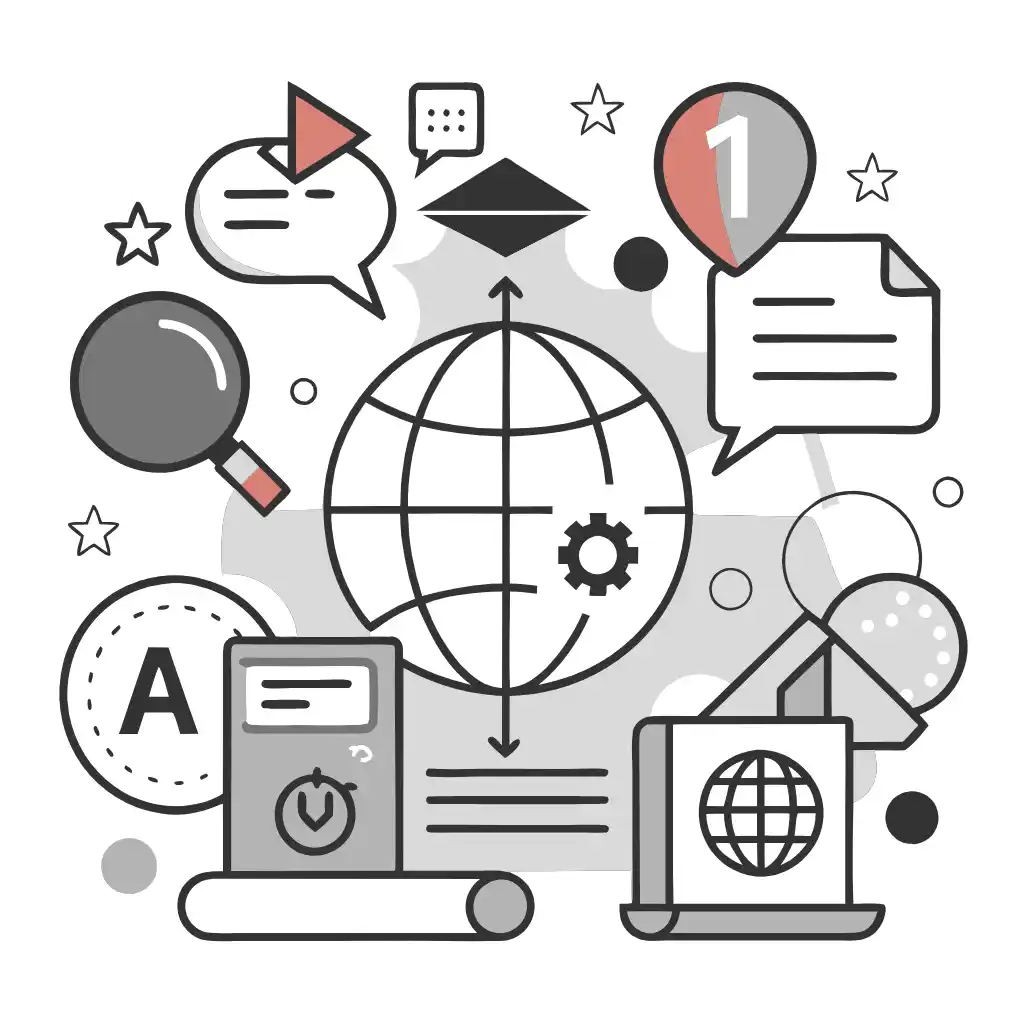Kosten voor het vertalen van een website: waar moet u rekening mee houden met ConveyThis
Evaluatie van de kosten, methoden en waarde van websitevertalingen
Omdat 41% van de internetgebruikers wereldwijd geen Engels spreekt, biedt websitevertaling grote mogelijkheden voor mondiale groei en grotere inkomstenstromen. Maar het nauwkeurig inschatten van de verschillende kosten, processen en waarde die gepaard gaan met het lokaliseren van uw online aanwezigheid in verschillende talen kan lastig zijn.
Deze uitgebreide gids onderzoekt grondig de voor-, nadelen en prijsimplicaties van verschillende websitevertaalmethoden. We schetsen de beslissingsfactoren zodat u de ideale aanpak kunt bepalen die past bij uw unieke budget, behoeften en strategische doelen. U krijgt duidelijkheid over het toewijzen van middelen om uw aanwezigheid op het web te lokaliseren voor een maximale ROI.


Inzicht in de businesscase voor websitevertaling
Hoewel het uitvoeren van een volledige websitevertaling misschien niet zinvol is voor strikt kleine, lokale fysieke bedrijven, kunnen de meeste bedrijven tegenwoordig aanzienlijke voordelen realiseren door hun bereik proactief uit te breiden tot buiten de Engelstalige markten.
Door uw website aan te passen voor twee, drie of meer talen kunt u:
- Gekwalificeerde bezoekers uit het buitenland bereiken: Nieuwe bezoekers betekent nieuwe leads en klanten. Het is nu mogelijk om relevant buitenlands verkeer naar uw site te leiden door middel van vertalingen.
- Vertrouwen en geloofwaardigheid opbouwen op buitenlandse markten: Door de taal van uw publiek te spreken, kweekt u goodwill en laat u zien dat u hun cultuur respecteert. Dit helpt bezoekers te overtuigen om te converteren.
- Internationale zichtbaarheid en inkomsten vergroten: Meer talen zorgen voor meer organische zoekzichtbaarheid in het buitenland. Hogere zichtbaarheid betekent hogere conversies en verkopen vanuit nieuwe regio's.
- Meer inclusieve ervaringen creëren voor alle gebruikers: Vertaling maakt het mogelijk om in contact te komen met diverse bezoekers in hun moedertaal, voor meer comfort en betrokkenheid.
Als het een doel is om te profiteren van buitenlandse markten door producten of diensten wereldwijd te verkopen, dan moet websitevertaling worden gezien als de noodzakelijke basis en katalysator voor het bredere internationale succes van uw bedrijf.
Laten we nu eens dieper ingaan op het evalueren van de beschikbare vertaalbenaderingen om optimale oplossingen te identificeren voor het kosteneffectief lokaliseren van uw aanwezigheid op het web.
Machine vertaling
Machinevertaling maakt gebruik van kunstmatige intelligentie om tekst programmatisch tussen talen te vertalen. Deze aanpak is de drijvende kracht achter populaire gratis diensten als Google Translate en DeepL.
De belangrijkste voordelen van automatische vertaling zijn de razendsnelle doorlooptijd dankzij de automatisering ervan, en de volledig gratis toegang van providers als Google. Deze factoren maken het ideaal om zeer snel vertaalde website-uitvoer op grote schaal te verkrijgen.
Bij onbewerkte machinevertalingen ontbreekt het echter aan kwaliteitscontrole of verfijning. U moet de vertaalde tekst handmatig op websites kopiëren en plakken, onvermijdelijke fouten herstellen en de websitelokalisatie verzorgen, waarbij u de terminologie en frasering aanpast aan culturele relevantie. Er worden ook geen ingebouwde meertalige SEO-mogelijkheden geboden.
Dus terwijl machinevertaling direct een kernvertaling oplevert, kunt u aanzienlijke inspanningen verwachten in het formatteren, verfijnen en effectief implementeren van de uitvoer op uw vertaalde sites, waardoor de tijdwinst afneemt.


Handmatige doe-het-zelf-vertaling
Als u de website-inhoud zelf wilt vertalen of op uw eigen team wilt vertrouwen, is het noodzakelijk dat u zowel de brontaal van uw site als elke doeltaal beheerst. Als handmatig proces wordt dit al snel extreem tijdrovend en vervelend, zelfs voor kleinere websites.
Het intern uitvoeren van vertalingen lijkt op voorhand misschien gratis, maar de enorme inspanning die daarvoor nodig is, komt neer op substantiële verborgen kosten in de daadwerkelijk geïnvesteerde tijd van het personeel. De schaalbaarheid is ook ernstig beperkt op basis van de beschikbare interne taalvaardigheden. Professionele nauwkeurigheid is onwaarschijnlijk tenzij uw team uit deskundige taalkundigen bestaat.
Voor zeer kleine statische websites die uw team met succes kan onderhouden, is handmatige vertaling echter een optie die minimale technische expertise vereist. Maar het groeipotentieel blijft beperkt gezien de afhankelijkheid van interne menselijke vertaalbandbreedte.
Professionele menselijke vertaling
Het inhuren van professionele menselijke vertaaldiensten, meestal vertaalbureaus, levert resultaten van de hoogste kwaliteit op, maar brengt ook hoge kosten met zich mee. De prijs wordt meestal bepaald per vertaald woord, variërend van ongeveer 8 tot 25 cent per woord.
Een website van 10.000 woorden zou dus beginnen bij een minimum van $800 voor één taalrichting. Vermenigvuldig dit met extra talen en de kosten lopen snel op. De lopende kosten zijn ook aanzienlijk, omdat voor elk nieuw stuk tekst of inhoud dat aan uw site wordt toegevoegd, extra vertaalkosten nodig zijn.
Er is nog steeds veel handmatig projectmanagement nodig, waarbij menselijke vertalingen externe bronnen coördineren. Professionele diensten missen ook de technische mogelijkheden om vertaalde websites automatisch te publiceren en te optimaliseren voor SEO.
Voor kleine sites die slechts één of twee talen nodig hebben, kan deze high-touch aanpak zinvol zijn als kwaliteit de hoogste prioriteit heeft. Maar kosten, overhead en het bijwerken van inhoud blijven op grotere schaal zeer inefficiënt.


Vertaalsoftware
Robuuste vertaalsoftwareplatforms zoals ConveyThis zijn speciaal gebouwd om de inherente nadelen van andere methoden via AI te elimineren. Deze opkomende optie combineert de voordelen van onmiddellijke automatische vertaling van hoge kwaliteit en professionele menselijke verfijning voor geoptimaliseerde kostenefficiëntie en betrouwbaarheid.
De software maakt eerst gebruik van AI-engines zoals Google en DeepL om alle websitetekst automatisch op bedrijfsschaal te vertalen, waardoor de kosten worden verlaagd. U heeft dan de volledige controle om elke tekst handmatig te verfijnen of ter beoordeling aan geïntegreerde professionele vertalers te delegeren.
De lopende kosten blijven extreem laag omdat het vertalen van extra tekst automatisch in bulk wordt afgehandeld, in tegenstelling tot traditionele prijsmodellen per woord. En geïntegreerde SEO-optimalisatie, projectmanagement, samenwerkingstools en eenvoudig meertalig publiceren van websites ronden de belangrijkste mogelijkheden af die bij andere methoden ontbreken.
Voor de meeste websites biedt deze geoptimaliseerde mix van automatisering en menselijk contact de beste algehele waarde, waardoor de kosten worden geminimaliseerd en toch een hoge kwaliteit en flexibiliteit wordt bereikt.
Afzonderlijke dubbele websites maken
Eén benadering is om voor elke doeltaal geheel nieuwe, afzonderlijke websites op te zetten – bijvoorbeeld mycompany.com voor Engels, mycompany.fr voor Frans, enz.
Hoewel het conceptueel eenvoudig is, is het lanceren en onderhouden van dubbele sites voor alle talen in de praktijk extreem duur, waardoor uitgebreid ontwikkelingswerk, infrastructuur en overhead nodig zijn. Het voortdurend synchroniseren van vertalingen tussen sites wordt ook complex en arbeidsintensief.
Over het algemeen is dit alleen zinvol voor een zeer klein aantal op zichzelf staande microsites, niet voor volledige websites. Anders stijgen de kosten terwijl de publicatiesnelheid afneemt.


Talen consolideren op één enkele site
Een veel efficiëntere methode is het gebruik van vertaalsoftware zoals ConveyThis, die alle talen consolideert op één enkel websiteplatform dat vertaalde tekst dynamisch aan bezoekers levert op basis van hun taalvoorkeur.
Dit vermijdt alle hoge kosten en complexiteit die gepaard gaan met het lanceren van een afzonderlijke infrastructuur voor elke taal. Er is geen ontwikkelings- of engineeringwerk nodig en sites kunnen eenvoudig worden bijgewerkt en geoptimaliseerd, waarbij de vertalingen automatisch worden gesynchroniseerd.
Voor de overgrote meerderheid van websites biedt het consolideren van meertalige inhoud op één enkele technologiestapel met behulp van vertaalsoftware ongeëvenaarde efficiëntie en handhaaft het de eenvoud naarmate sites groter worden.
Maak sociale media-accounts aan
Sociale media zijn een krachtig middel om de geloofwaardigheid van uw site te vergroten, bezoekers naar uw website te trekken en de merkherkenning te vergroten. Het biedt u ook een extra platform om in contact te komen met invloedrijke mensen over de hele wereld, wat u kan helpen een hogere ranking in relevante zoekmachines te bereiken.
Maak gebruik van de kracht van sociale media om uw bereik te vergroten en contact te maken met uw publiek. Meld u aan voor accounts op platforms die relevant zijn voor uw sector en gebruik deze om interessante inhoud en links te plaatsen die in uw doelland worden gedeeld. Maak gebruik van marketingtools voor sociale media om het meeste uit uw aanwezigheid op sociale media te halen.
Zorg er bovendien voor dat je een reeks hashtags opneemt en de meest geschikte sociale-media-outlet aanwijst voor elk bericht dat je maakt. Voeg bovendien uw websitelink toe aan alle berichten die u deelt, zodat lezers snel uw website kunnen bereiken voor meer gegevens over u en uw bedrijf. Hierdoor worden leads gecreëerd en mogelijk omgezet in betalende klanten.


Conclusie
Als u uw online aanwezigheid verder wilt uitbreiden dan alleen Engels, is een zorgvuldige evaluatie van vertaalopties en budgetoverwegingen noodzakelijk. Het kosteneffectief maken van meertalige websites met behoud van de kwaliteit vereist het identificeren van de aanpak die het beste aansluit bij uw zakelijke doelstellingen, middelen en mogelijkheden.
Voor de meeste organisaties levert het gebruik van geavanceerde vertaalsoftware een ongeëvenaarde mix van automatisering, kwaliteit en technische implementatie op tegen zeer toegankelijke prijzen in vergelijking met traditionele modellen die afhankelijk zijn van handmatige processen.
Met ConveyThis is er geen technische expertise vereist om snel het mondiale potentieel van een website te ontsluiten en nieuwe internationale bezoekers in hun moedertaal aan te trekken – een belangrijke katalysator voor de mondiale groei. ConveyThis biedt een risicovrije proefperiode waarin u de voordelen uit de eerste hand kunt ervaren.
Vertalen is, veel meer dan alleen het kennen van talen, een complex proces.
Als u onze tips opvolgt en ConveyThis gebruikt, zullen uw vertaalde pagina's aanslaan bij uw publiek en aanvoelen alsof ze de doeltaal beheersen.
Hoewel het moeite kost, is het resultaat lonend. Als u een website vertaalt, kan ConveyThis u uren besparen met geautomatiseerde machinevertaling.
Probeer ConveyThis 7 dagen gratis!